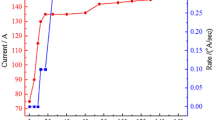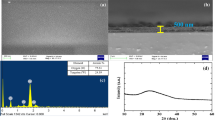Abstract
Tungsten oxide electrochromic (EC) thin films are prepared by physical vapor deposition (PVD) method in vacuum on fluorine doped tin oxide (FTO) coated glass substrate. In order to provide different surface morphology, the FTO-coated glass substrates are used in two deferent modes. The first sample is deposited at an angle of 0° and the second sample deposited at an angle of 75°. In this method, WO3 nanoparticles powder with the same rate are deposited in vacuum. The Ag nanoparticles powder is utilized to decorate the surface of each of WO3 thin films by using PVD method. The EC thin films are annelid to inject the Ag nanoparticles into the surface of thin films. The band gap of WO3–Ag thin films are reported for indirect transitions. EC properties of WO3–Ag thin films are investigated by cyclic voltammetry and the visible transmittance to compare the influence of surface morphology of WO3–Ag thin films on EC performance. In particular, a significant optical modulation (40.59% at 632.8 nm) and high coloration efficiency (90.2 cm2 C−1 at 632.8 nm) are enhanced for the second sample compared to the first sample.














Similar content being viewed by others
References
S. Vidya, S. Solomon, J.K. Thomas, Synthesis and characterisation of MoO3 and WO3 nanorods for low temperature co-fired ceramic and optical applications. J. Mater. Sci.: Mater. Electron. 26(5), 3243–3255 (2015)
Y.E. Firat, A. Peksoz, Electrochemical synthesis of polyaniline/inorganic salt binary nanofiber thin films for electrochromic applications. J. Mater. Sci.: Mater. Electron. 28(4), 3515–3522 (2017)
M. Roeder, A.B. Beleke, U. Guntow, J. Buensow, A. Guerfi, U. Posset, H. Lorrmann, K. Zaghib, G. Sextl, Li4Ti5O12 and LiMn2O4 thin-film electrodes on transparent conducting oxides for all-solid-state and electrochromic applications. J. Power Sources 301, 35–40 (2016)
H. Najafi-Ashtiani, A. Bahari, S. Ghasemi, A dual electrochromic film based on nanocomposite of copolymer and WO3 nanoparticles: enhanced electrochromic coloration efficiency and switching response. J. Electroanal. Chem. 774, 14–21 (2016)
X. Wu, W. Zhang, Q. Wang, Y. Wang, H. Yan, W. Chen, Hydrogen bonding of graphene/polyaniline composites film for solid electrochromic devices. Synth. Met. 212, 1–11 (2016)
G.Y. Sun, X. Cao, H. Zhou, S. Bao, P. Jin, A novel multifunctional thermochromic structure with skin comfort design for smart window application. Sol. Energy Mater. Sol. Cells 159, 553–559 (2017)
M. Hočevar, U.O. Krašovec, Cubic WO3 stabilized by inclusion of Ti: applicable in photochromic glazing. Sol. Energy Mater. Sol. Cells 154, 57–64 (2016)
R. Lakshmanan, P.P. Raja, N.C. Shivaprakash, S. Sindhu, Fabrication of fast switching electrochromic window based on poly (3, 4-(2, 2-dimethylpropylenedioxy) thiophene) thin film. J. Mater. Sci.: Mater. Electron. 27(6), 6035–6042 (2016)
S. Oukassi, C. Giroud-Garampon, C. Dubarry, C. Ducros, R. Salot, All inorganic thin film electrochromic device using LiPON as the ion conductor. Sol. Energy Mater. Sol. Cells 145, 2–7 (2016)
S.Y. Kao, C.W. Kung, H.W. Chen, C.W. Hu, K.C. Ho, An electrochromic device based on all-in-one polymer gel through in-situ thermal polymerization. Sol. Energy Mater. Sol. Cells 145, 61–68 (2016)
S. Zhang, R. Fu, Y. Gu, L. Dong, J. Li, S. Chen, Preparation of nanocellulose-based polyaniline composite film and its application in electrochromic device. J. Mater. Sci.: Mater. Electron. 28(14), 10158–10165 (2017)
H. Najafi-Ashtiani, A. Bahari, S. Ghasemi, A dual electrochromic film based on nanocomposite of aniline and o-toluidine copolymer with tungsten oxide nanoparticles. Org. Electron. 37, 213–221 (2016)
A.K. Chaudhari, V.B. Singh, Mechanical and physical properties of electrodeposited Ni–Fe, WO3 doped nanocomposite. Surf. Coat. Technol. 307, 683–692 (2016)
R. Mukherjee, P.P. Sahay, Effect of precursors on the microstructural, optical, electrical and electrochromic properties of WO3 nanocrystalline thin films. J. Mater. Sci.: Mater. Electron. 26(8), 6293–6305 (2015)
S.J. Lu, C. Wang, H. Wang, J.B. Liu, H. Yan, Excellent electrochromic properties of tungsten oxide films with a mesoporous structure. J. Mater. Sci.: Mater. Electron. 1–7 (2017)
L. Wang, Y.R. Hu, G.Q. Li, W. Xie, Formation and transmittance property of WO3 films deposited by mid-frequency dual-target magnetron sputtering. Surf. Coat. Technol. 201(9), 5063–5067 (2007)
K.W. Park, Electrochromic properties of Au–WO3 nanocomposite thin-film electrode. Electrochim. Acta 50, 4690–4693 (2005)
M.A. Gondal, M.A. Suliman, M.A. Dastageer, G.K. Chuah, C. Basheer, D. Yang, A. Suwaiyan, Visible light photocatalytic degradation of herbicide (Atrazine) using surface plasmon resonance induced in mesoporous Ag-WO3/SBA-15 composite. J. Mol. Catal. A 425, 208–216 (2016)
H. Najafi-Ashtiani, A. Bahari, Optical, structural and electrochromic behavior studies on nanocomposite thin film of aniline, o-toluidine and WO3. Opt. Mater. 58, 210–218 (2016)
Y. Baek, K. Yong, Controlled growth and characterization of tungsten oxide nanowires using thermal evaporation of WO3 powder. J. Phys. Chem. C 111(3), 1213–1218 (2007)
M. Nazari, F. Golestani-Fard, R. Bayati, B. Eftekhari-Yekta, Enhanced photocatalytic activity in anodized WO3-loaded TiO2 nanotubes. Superlattices Microstruct. 80, 91–101 (2015)
M. Murugavelu, B. Karthikeyan, Study of Ag–Pd bimetallic nanoparticles modified glassy carbon electrode for detection of L-cysteine. Superlattices Microstruct. 75, 916–926 (2014)
M. Bielmann, P. Schwaller, P. Ruffieux, O. Gröning, L. Schlapbach, P. Gröning, AgO investigated by photoelectron spectroscopy: evidence for mixed valence. Phys. Rev. B 65(23), 235431 (2002)
R.R. Kharade, S.S. Mali, S.P. Patil, K.R. Patil, M.G. Gang, P.S. Patil, J.H. Kim, P.N. Bhosale, Enhanced electrochromic coloration in Ag nanoparticle decorated WO3 thin films. Electrochim. Acta 102, 358–368 (2013)
Z. Liu, J. Wu, J. Zhang, Quantum dots and plasmonic Ag decorated WO3 nanorod photoanodes with enhanced photoelectrochemical performances. Int. J. Hydrogen Energy 41(45), 20529–20535 (2016)
N. Naseri, R. Azimirad, O. Akhavan, A.Z. Moshfegh, Improved electrochromical properties of sol–gel WO3 thin films by doping gold nanocrystals. Thin Solid Films 518, 2250–2257 (2010)
O.D. Coşkun, S. Demirel, G. Atak, The effects of heat treatment on optical, structural, electrochromic and bonding properties of Nb2O5 thin films. J. Alloy. Compd. 648, 994–1004 (2015)
S. Hoseinzadeh, R. Ghasemiasl, A. Bahari, A.H. Ramezani, The injection of Ag nanoparticles on surface of WO3 thin film: enhanced electrochromic coloration efficiency and switching response. J. Mater. Sci.: Mater. Electron. 28(19), 14855–14863 (2017)
H. Li, Y. Lv, X. Zhang, X. Wang, X. Liu, High-performance ITO-free electrochromic films based on bi-functional stacked WO3/Ag/WO3 structures. Sol. Energy Mater. Sol. Cells 136, 86–91 (2015)
Author information
Authors and Affiliations
Corresponding author
Rights and permissions
About this article
Cite this article
Najafi-Ashtiani, H., Bahari, A. & Gholipour, S. Investigation of coloration efficiency for tungsten oxide–silver nanocomposite thin films with different surface morphologies. J Mater Sci: Mater Electron 29, 5820–5829 (2018). https://doi.org/10.1007/s10854-018-8554-x
Received:
Accepted:
Published:
Issue Date:
DOI: https://doi.org/10.1007/s10854-018-8554-x




